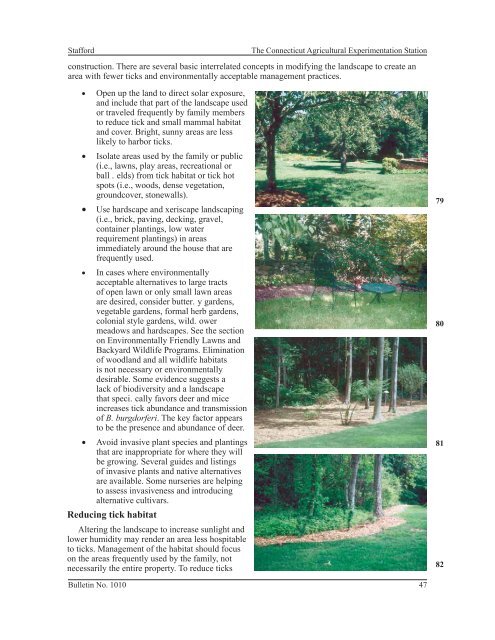Dr. Stafford Tick Management Handbook - Newtown, CT
Dr. Stafford Tick Management Handbook - Newtown, CT
Dr. Stafford Tick Management Handbook - Newtown, CT
You also want an ePaper? Increase the reach of your titles
YUMPU automatically turns print PDFs into web optimized ePapers that Google loves.
<strong>Stafford</strong>The Connecticut Agricultural Experimentation Stationconstruction. There are several basic interrelated concepts in modifying the landscape to create anarea with fewer ticks and environmentally acceptable management practices.• Open up the land to direct solar exposure,and include that part of the landscape usedor traveled frequently by family membersto reduce tick and small mammal habitatand cover. Bright, sunny areas are lesslikely to harbor ticks.• Isolate areas used by the family or public(i.e., lawns, play areas, recreational orball . elds) from tick habitat or tick hotspots (i.e., woods, dense vegetation,groundcover, stonewalls).• Use hardscape and xeriscape landscaping(i.e., brick, paving, decking, gravel,container plantings, low waterrequirement plantings) in areasimmediately around the house that arefrequently used.• In cases where environmentallyacceptable alternatives to large tractsof open lawn or only small lawn areasare desired, consider butter. y gardens,vegetable gardens, formal herb gardens,colonial style gardens, wild. owermeadows and hardscapes. See the sectionon Environmentally Friendly Lawns andBackyard Wildlife Programs. Eliminationof woodland and all wildlife habitatsis not necessary or environmentallydesirable. Some evidence suggests alack of biodiversity and a landscapethat speci. cally favors deer and miceincreases tick abundance and transmissionof B. burgdorferi. The key factor appearsto be the presence and abundance of deer.• Avoid invasive plant species and plantingsthat are inappropriate for where they willbe growing. Several guides and listingsof invasive plants and native alternativesare available. Some nurseries are helpingto assess invasiveness and introducingalternative cultivars.Reducing tick habitatAltering the landscape to increase sunlight andlower humidity may render an area less hospitableto ticks. <strong>Management</strong> of the habitat should focuson the areas frequently used by the family, notnecessarily the entire property. To reduce ticks79808182Bulletin No. 1010 47











